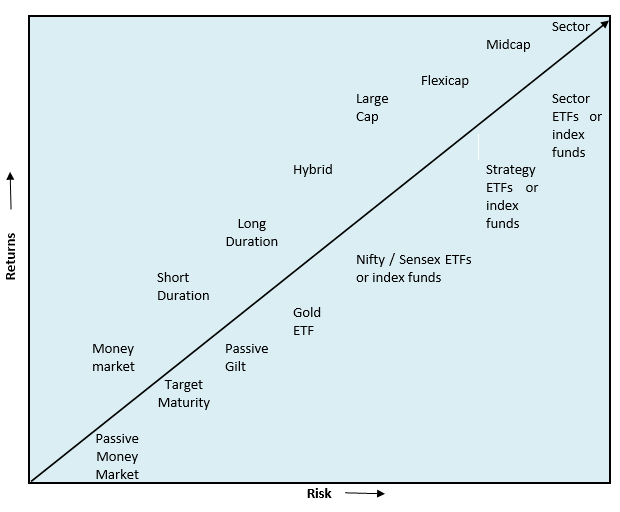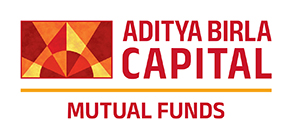Equity and debt passive funds: What you need to know about investing in passive funds?

Passive funds – Global trend
Passive funds are mutual fund schemes which track a benchmark market index. Unlike actively managed funds passive funds do not aim to beat the benchmark index. Passive investments have gained increasing popularity globally, over the last 2 decades, especially in developed markets. In the US, passive equity assets (AUM) overtook active equity assets last year (source: Financial Times, June 2022). As per a Bloomberg report (February 2023), global passive equity AUM is expected to overtake active equity AUM sometime in 2023 according to forecast of Societe Generale.
Passive funds in India
Indian investors have traditionally favoured active mutual funds but India is also following the global trend. Passive investing took off in a big way since the outbreak of the COVID-19 pandemic. As per AMFI data, in the last 4 years ending June 30th 2023, passive AUM grew by nearly 4 times at a CAGR of nearly 40% (source: AMFI June 2023 data). As on 30th June 2023, passive AUM stood at over Rs 7 lakh crores. While institutional investors e.g. EPFO contribute a significant portion of the passive AUM in India, retail investors interest in passive funds is also increasing.
Investors have two options for passive investing – Exchange Traded Fund (ETF) and Index Funds. Currently there are more than 350 ETF and Index Fund products in India across different asset classes. In this article, we will discuss about equity and debt passive funds. But before we delve into these two asset classes for passives, a brief description of ETFs and index funds for the benefit of retail investors, who may not be familiar with these products.
What are ETFs?
Exchange traded funds (ETFs) are passive schemes tracking market benchmark indices like Nifty, Sensex etc. ETFs do not aim to beat the market benchmark index they are tracking; they simply aim to give market returns. ETFs are listed in stock exchanges and trade like shares of companies. You need to have Demat and trading accounts to invest in ETFs. Currently there are around 172 ETFs listed in stock exchanges. If you want information about individual ETFs please visit Advisorkhoj ETF Corner.
What are Index Funds?
Index funds are also passive mutual fund schemes which track market benchmark indices like Nifty 50, Sensex etc. Index funds are very similar to ETFs with one major difference. Index funds are like any other open ended mutual fund scheme. You do not need Demat and trading accounts to invest in index funds. You can invest in index funds either directly with the Asset Management Company (AMC) or through your mutual fund distributor. Currently, there are around 190 index funds available for investments.
Equity passive funds
Equity passive funds track equity market indices e.g. Sensex, Nifty, Bank Nifty etc. The equity passive funds invest in a basket of stocks that mirror the composition of the benchmark index. The weight of each stock in fund portfolio mirrors the weight of the index constituent in the index e.g. if the weight of a stock in Nifty 50 index is 4%, then the weight of the same stock in a Nifty 50 ETF or Nifty 50 Index Fund portfolio will be as close to 4% as possible. Stock indices are rebalanced by the exchanges from time to time (e.g. Nifty 50 index is rebalanced every 6 months). ETFs also rebalance their underlying portfolio to mirror the index.
Tracking differences and errors
The expected returns of an equity passive fund will mirror the returns of the underlying index subject to tracking differences / errors. Tracking difference is the difference between the fund and index returns over different investment periods e.g. 1 year, 3 years, 5 years etc. Tracking error is defined as the annualized standard deviation of the differences in monthly returns of the fund and the benchmark.
Causes of tracking differences / errors
Tracking difference or error can be caused by a number of factors, the most important being the expense (TER) of the fund. Higher the Total Expense Ratio (TER), higher will be the tracking error. Another cause of tracking differences / errors can be circuit filters imposed by the stock exchange preventing the fund from purchasing the stocks in the desired quantity or price needed to replicate the index at the time of rebalancing. Finally, passive funds have cash holdings while indices do not have any cash. This can also give rise to tracking differences / errors.
Different types of passive equity funds
There is a variety of choices available for equity investors:-
- Tracking different market cap indices: Different market capitalization segments e.g. large cap, midcap, small cap have different benchmark indices. Within large cap Nifty 50 (largest 50 stocks by market cap) and Sensex (largest 30 stocks by market cap) are the most popular indices. Sensex and Nifty ETFs / index funds are among the most popular passive funds. Within large cap, Nifty Next 50 (51st to 100th largest stocks by market cap) funds are also quite popular. If you want to invest in the broader market you can select passive funds tracking broader market indices e.g. midcap (Nifty Midcap 150), small cap (Nifty Small Cap 250), broad market (Nifty 500) etc.
- Tracking industry sectors indices: You can invest in different industry sectors through passive funds. There are passive funds tracking Banking and Financial Services (BFSI), Information Technology (IT), Fast Moving Consumer Goods (FMCG), Pharmaceuticals and Healthcare, Infrastructure, Automobile, etc. Among sector ETFs / index funds, Bank Nifty ETFs are among the most popular passive funds after Sensex and Nifty ETFs. We should mention that each industry sector has its own risk characteristics. You should understand the risk profile of the fund and invest according to your risk appetite.
- Tracking strategy indices: Strategy indices are constructed based on quantitative, rule based investment strategies e.g. dividend yield, momentum, value, low volatility, high beta, alpha, quality etc. Index constituents are selected based on defined quantitative models. Strategy indices can be a based on a single factor model e.g. dividend yield, momentum, high beta, low volatility etc, or multi-factor models combining Quality, Value, Alpha and Low Volatility. Strategy based investing requires knowledge of different investment strategies. You should consult your financial advisor, if you need help in understanding different strategy indices.
Why invest in passive equity funds?
- Passive funds have much lower cost (TER) compared to active funds. Unless an active fund is able to create significant alphas, they are likely to underperform versus passive funds tracking the same benchmark index.
- Fund managers of active funds are overweight or underweight on certain stocks relative to the benchmark index. This results in additional risk known as unsystematic risks. There is no unsystematic risk in passive funds. Passive funds are only subject to market risks.
- There is no human bias in passive funds since they track market index.
- There is a wide variety of investment choices for investors depending on their risk appetite and investment needs. You can take exposure in leading market indices, broader market, sectors or strategies through passive funds.
Debt passive funds
Passive debt funds are fixed income mutual fund schemes which track debt market or money market instruments. These funds invest in debt or money market instruments like Government Securities (Gilts / G-Secs), State Development Loans (SDL), PSU bonds, Tri Party Repos (TPTs) etc. Currently there are three types of passive debt funds – money market funds, Gilt / SDL funds and Target Maturity Funds.
Passive money market funds
Money market passive funds track the Nifty 1D rate index. Investors may consider these funds as alternative to active overnight funds but at the present time, passive funds tracking Nifty 1D rate index do not offer cost advantage in terms of TER compared to active overnight funds.
Passive Gilt / SDL funds
Gilt / SDL funds invest in G-Secs and State Development Loans (SDLs) of different maturities. Passive Gilt funds offer cost advantage (lower TER) compared to active Gilt funds. If you want to take a defined interest rate risk by investing in certain durations / maturities only, you may invest in passive Gilt / SDL funds. These funds track Nifty 5 year, 10 year, 8 – 13 year etc G-Sec indices. You should always invest according to risk appetite and investment tenure. You should consult with your financial advisor, if you need help in understanding your risk appetite and the risk profile of the fund.
Target Maturity Funds
Target maturity funds have the largest share of AUM among the passive debt funds. These funds track an underlying bond index with defined maturity dates. On maturity, you will get the maturity proceeds which will include the face value of the underlying bonds and the accrued interest.
How do target maturity funds work?
- Target maturity funds invest in Gilts, SDLs and PSU bonds that mirror an underlying bond index with defined maturity dates. All the bonds in the index mature on or before the maturity date of the index. For example, the underlying bonds of Bharat Bond Index Series - April 2025 will mature on or before April 2025.
- Target maturity funds hold bonds till maturity. The coupons (interest) of the bonds are re-invested in the underlying bonds. Since the bonds are held till maturity, there is no interest rate risk if you investment tenure matches with the target maturity date.
- Since bond prices are marked to market in the Net Asset Values (NAVs) of debt funds, the NAVs may fluctuate with changes in interest rate. However the interest rate risk of target maturity funds reduces over the maturity period since the residual maturity of the underlying bonds keep reducing over the investment tenure.
Why invest in passive debt funds?
- Lower cost (TER) compared to active funds. For investors who do not want to take credit risks, low cost can result in higher net yields / returns.
- Target maturity funds provide visibility of returns, if your investment tenure matches with the target maturity date
- Passive debt funds invest in TREPs, G-Secs, SDLs and PSU bond. TREPs are 100% backed by G-Secs. SDLs are issued by State Governments and backed by RBI, which guarantees interest and principal payments to investors. PSU bonds also enjoy quasi sovereign status. As such, credit quality of passive funds is very high.
Goal planning with diverse passive funds
You have different goals for different stages of life, e.g. purchasing car, property, paying off loans, children’s higher education, children’s marriage, retirement planning, leaving a legacy for your children and grandchildren etc. You need to save and invest for these financial goals. Some of these goals are short term, while some are medium and long term. Diverse passive funds can be investment solutions for different short, medium and long term goals. For example, you can invest in passive debt funds e.g. target maturity funds for your short to medium term goals (e.g. 2 years, 3 years, 5 years etc). For your long term goals e.g. 5 years or longer you can invest in passive equity funds.
Why you need to have a mix of active and passive funds in your portfolio?
Different investors have different risk appetites and investment needs. Both active and passive funds offer investment solutions for diverse risk profiles and investment requirements. You should construct your portfolio with a mix of active and passive funds based on your requirements and risk profile of the schemes. The chart below shows the risk / return mapping of select active and passive fund categories.

Disclaimer: The chart below is purely illustrative and not exhaustive. The risk return mapping is only indicative and should not be construed as investment recommendation. You should consult with your financial advisor before investing
Should you invest ETFs or Index Funds?
In this article, we have discussed about passive equity and debt funds. As mentioned earlier in this article, you have two options for passive investing – ETFs or Index Funds for both equity and debt. How will you decide between the two? Consider the following factors:-
- You need to have Demat and trading accounts to invest in ETFs. If you do not have Demat and trading accounts you can invest in index funds.
- TERs of ETFs is usually lower than index funds.
- You can buy / sell units of ETFs only in stock exchanges, unless you are transacting in lot sizes (creation units) specified in the Scheme Information Document (SID).
- You can take advantage of intraday price movements in ETF transactions. Index fund transactions are based on end of day NAVs like other mutual fund schemes.
- Liquidity is an important consideration when you are investing in ETFs. If your ETF is not sufficiently liquid, you may face difficulties in extreme market conditions.
- You can invest in index funds through Systematic Investment Plan (SIP). AMCs do not provide SIP facility for ETFs
- If you have experience of investing directly in the stock market then you can invest in ETFs to take advantage of lower costs. Investors who do not have experience of investing in stock market maybe more comfortable with index funds.
You should make informed decisions based on your experience and needs. You should consult with your financial advisor or mutual fund distributor if you need help in making investment decisions.
Disclaimer: An Investor education and Awareness initiative of Aditya Birla Sun Life Mutual Fund.
All investors have to go through a one-time KYC (Know Your Customer) process. Investors to invest only with SEBI registered Mutual Funds. For further information on KYC, list of SEBI registered Mutual Funds and redressal of complaints including details about SEBI SCORES portal, visit link https://mutualfund.adityabirlacapital.com/Investor-Education/education/kyc-and-redressal for further details.
Mutual Fund Investments are subject to market risk, read all scheme related documents carefully.
RECOMMENDED READS
LATEST ARTICLES
- Investor Rights in Mutual Funds
- Responsibilities of Regulators and Key Constituents of the Mutual Fund Industry
- ABSL Balanced Advantage Fund: A proven all seasons fund for growth and stability
- ABSL SIP for Life: Plan to build and enjoy your wealth
- Aditya Birla Sun Life Flexi Cap Fund: Legendary track record of wealth creation
Follow Birla Sun Life MF
More About ABSL MF
POST A QUERY






